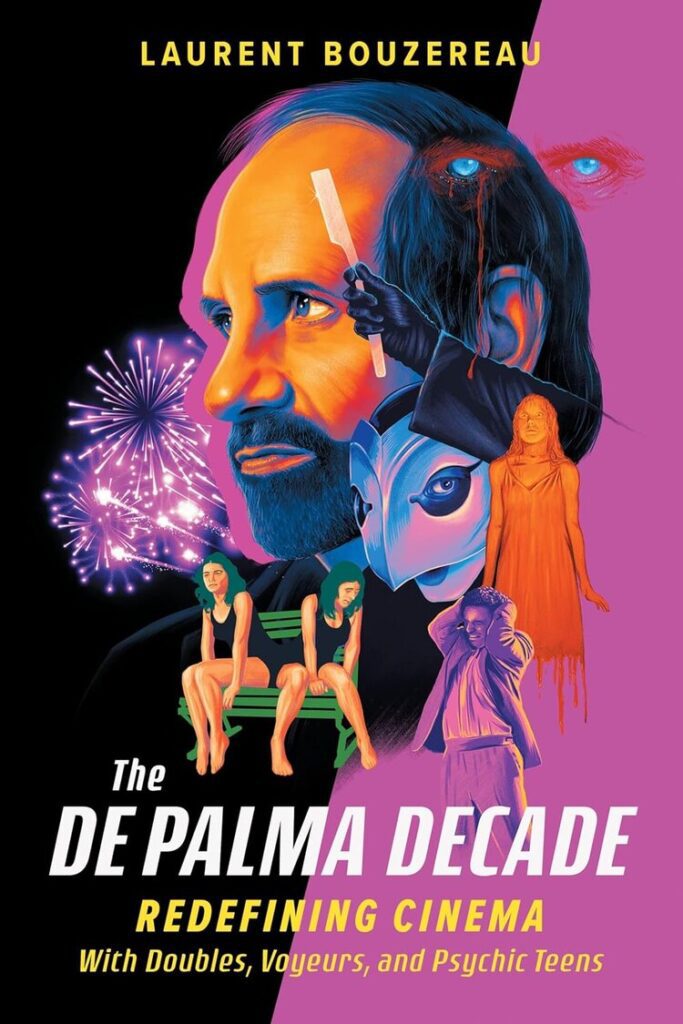
Laurent Bouzereau’s The De Palma Decade (Running Press) is a valentine to director Brian De Palma’s provocative 1970s run. Divided into three sections—“The Split” (Sisters, Dressed to Kill), “The Power” (Carrie, The Fury), and “The Tragedies” (Phantom of the Paradise, Obsession, Blow Out)—the book categorizes De Palma’s films by themes of voyeurism, duality, and inevitable tragedy. With its scrapbook feel (quotes and anecdotes crowd the pages), it focuses more on celebrating the movies than providing deep analysis. As a breezy tribute to early De Palma, it succeeds on its own superficial terms. I’m a De Palma devotee; I share Bouzereau’s enthusiasm for this period when the director’s fusion of high art and pulpy thrills was electrifying. His work from this era was daring and technically brilliant.
Buy The De Palma Decade: Redefining Cinema with Doubles, Voyeurs, and Psychic Teens bookWhile Bouzereau’s structure is clever, it can create the sense that he is attempting to compartmentalize these films neatly without thoroughly examining De Palma’s evolution as a filmmaker. The book is a stockade of quotes and anecdotes that skims the surface. It doesn’t offer a thorough analysis. Why limit the focus to thematic groupings when De Palma’s odd, messy experiments—like Hi, Mom! (1970), Get to Know Your Rabbit (1972) and Home Movies (1979)—add texture to his career? These outliers don’t fit the “perfect decade” narrative, but that’s why Bouzereau should discuss them. De Palma wasn’t just making slick, sexy thrillers—he took enormous risks. By leaving out these oddballs, Bouzereau plays it a little too safe for a director like De Palma.
For a more revealing portrait, the 2015 documentary De Palma (dir. Noah Baumbach, Jake Paltrow) offers a sharper reflection. In that film, De Palma provides insight into his technical wizardry—though, like any great magician, he keeps plenty of secrets hidden. Bouzereau’s book, by comparison, seems like a rehash of material already available on Blu-ray and DVD extras, offering more admiration than fresh critical examination. It’s an enjoyable read, but one that lacks the penetrating analysis De Palma’s audacious style deserves.
Take Blow Out (1981), for example. Bouzereau says it culminates De Palma’s 1970s work. It’s true, but Bouzereau doesn’t fully explain why. It’s not enough to say Blow Out ties together De Palma’s obsessions; we need more about how he refined his craft from films like Carrie and Sisters to reach a new level of cinematic mastery. Bouzereau hints at this, but never precisely engages.
And Bouzereau’s decision to limit the book to De Palma’s ’70s output is a missed opportunity. Why ignore the rest of the ’80s, despite Blow Out bringing the ’70s era to such an impressive conclusion? Scarface, Body Double, The Untouchables, Casualties of War, and Mission: Impossible all built on the groundwork laid in the ’70s and deserve attention. By cutting off with the ’70s, Bouzereau implies that De Palma peaked early. This is inaccurate and unfair.
Overall, Bouzereau’s passion for De Palma is infectious, and the book is breezy and fun—a nostalgic trip for fans of early De Palma. I’ll revisit it. But The De Palma Decade never quite captures the exhilarating sense of danger and amusement that pulses through De Palma’s best films. I craved a sharper critical eye, more personal reflection, and a deeper interrogation of what makes these movies tick. For a filmmaker who built a reputation on pushing boundaries, a quirkier or more incisive approach could have made this tribute hit as hard as De Palma’s greatest work. Still, The De Palma Decade is an entertaining celebration of a thrilling era in De Palma’s career.